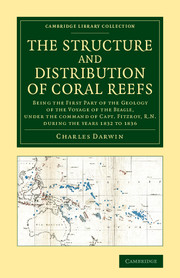
-
Select format
-
- Publisher:
- Cambridge University Press
- Publication date:
- 05 December 2014
- 19 September 2013
- ISBN:
- 9781107325098
- 9781108065627
- Dimensions:
- Weight & Pages:
- Dimensions:
- (216 x 140 mm)
- Weight & Pages:
- 0.31kg, 236 Pages
You may already have access via personal or institutional login
Book description
Published in 1842, this important monograph by Charles Darwin (1809–82) formed the first part of a trilogy of geological studies based on observations made during the celebrated second voyage of the Beagle. Influenced by Charles Lyell's Principles of Geology, Darwin drew in particular on data from the survey of the Keeling Islands in the Indian Ocean to support his theory that subsidence of the ocean floor can account for the formation of coral atolls. He first presented his findings in a paper for the Geological Society of London in 1837, but a heavy workload and illness delayed the appearance of this elegantly argued and illustrated study. For this and his work on barnacles, Darwin would receive the Royal Society's royal medal in 1853. The other studies in the trilogy, Geological Observations on the Volcanic Islands (1844) and Geological Observations on South America (1846), are also reissued in this series.
Contents
Metrics
Altmetric attention score
Full text views
Full text views help Loading metrics...
Loading metrics...
* Views captured on Cambridge Core between #date#. This data will be updated every 24 hours.
Usage data cannot currently be displayed.
Accessibility standard: Unknown
Why this information is here
This section outlines the accessibility features of this content - including support for screen readers, full keyboard navigation and high-contrast display options. This may not be relevant for you.
Accessibility Information
Accessibility compliance for the PDF of this book is currently unknown and may be updated in the future.


